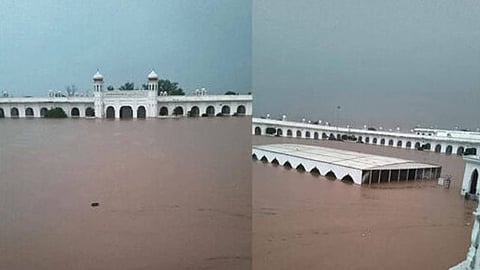

The historic gurdwara, one of the holiest shrines, is believed to be the final resting place of Guru Nanak Dev, the founder of the Sikh religion. It is located in Pakistan’s Narowal district.
The gurdwara is connected to the Indian side via the Kartarpur Sahib Corridor, situated at the Zero Point on the International Boundary. However, the corridor in Gurdaspur district has also been partially submerged by floodwater, leading to its suspension by the district administration.
Visuals show the entire Kartarpur Sahib complex partially submerged, with floodwaters entering the sanctum of Gurdwara Darbar Sahib. Three to four feet of water stands across the premises.
Fortunately , the sacred Saroop of Guru Granth Sahib-ji and “sevadars” have been safely moved to the first floor of the Darbar Sahib.
Local authorities are making arrangements to evacuate “sevadars” if the situation worsens.
While waters have submerged fields and villages in the vicinity of the Kartarpur Sahib Corridor, the residential areas remain safe, according to officials.
Originally known as Gurdwara Darbar Sahib, the Gurdwara Kartarpur Sahib, located on the banks of the Ravi River, was built to commemorate the site where Guru Nanak settled after his missionary work.
Guru Nanak is believed to have lived for 18 years at Darbar Sahib until his death in 1539.
Guru Nanak settled down in Kartarpur on his farm on the banks of the Ravi River, as per the Shiromani Gurdwara Parbandhak Committee (SPGC), the governing body of the Sikh community.
Guru Nanak shed the pilgrim’s attire and embraced the clothes of a householder.
Over centuries, the course of the Ravi River changed, and the part of the farm where Guru Nanak passed away in 1539 is now on the Pakistani side of the river. Gurdwara Dera Baba Nanak, where Guru Nanak used to meditate daily, stands on the Indian side of the border.
The SGPC also mentioned that a chola (robe) gifted to Guru Nanak during his visit to Mecca is preserved in the gurdwara.
Born on April 15, 1469, in Rai-Bhoi-di Talwandi in Pakistan’s Shekhupura district, now known as Nankana Sahib, Guru Nanak founded Sikhism.
The original structure of Kartarpur Sahib was destroyed by floods.
Bhupinder Singh, the then scion of Patiala and grandfather of former Punjab Chief Minister Amarinder Singh, reconstructed the shrine.
After the partition in 1947, the shrine was closed to people from across India’s border. However, it was reopened to pilgrims after repairs and restoration in 1999. Since then, Sikh jathas have been visiting the shrine regularly.
In April, a 500-year-old well, believed to have been constructed during the lifetime of Guru Nanak Dev, was discovered near the Kartarpur gurdwara.
The well was discovered while digging the enclosure of the shrine. Sikh 'jathas' from India travel to Pakistan on four occasions every year -- Baisakhi, the martyrdom day of Guru Arjan Dev, the death anniversary of Maharaja Ranjit Singh, and the birthday of Guru Nanak Dev.
Prime Minister Narendra Modi launched the Kartarpur Corridor in November 2019 when the first lot of 550 Indian pilgrims, led by former Prime Minister Manmohan Singh, visited the holy shrine across the border.